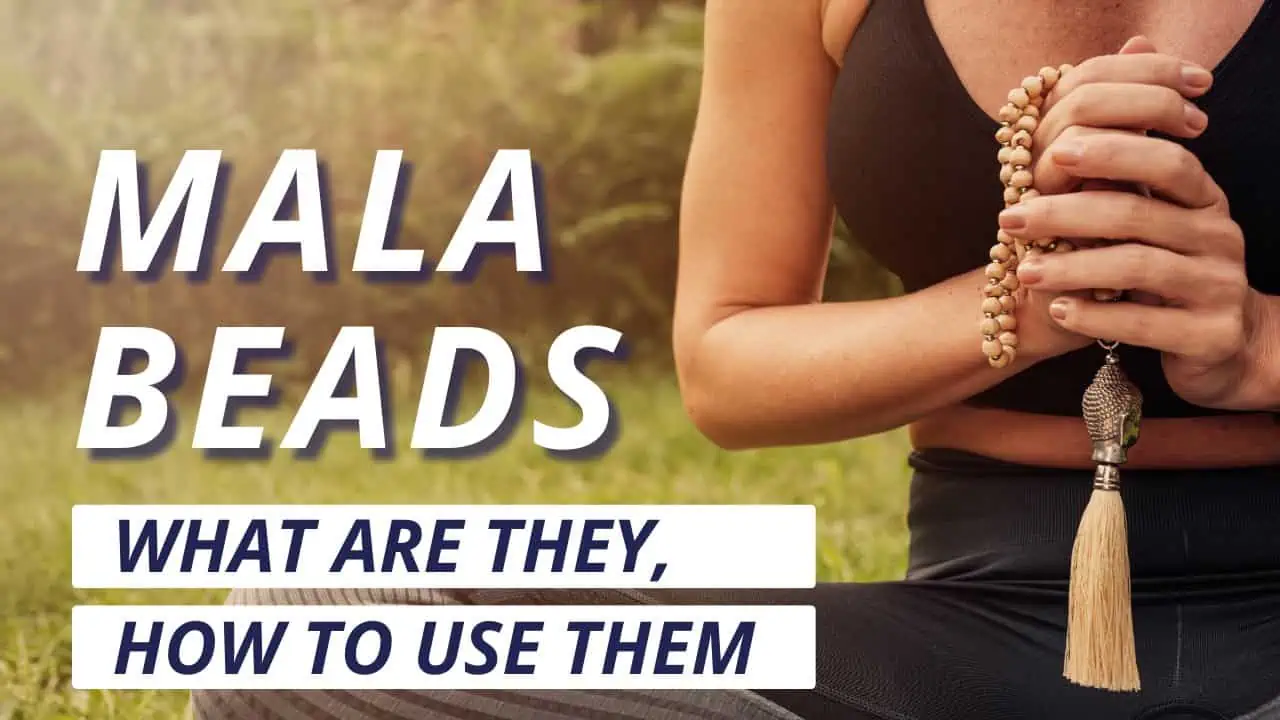Listen to this article:
Note from the Nomad: I’m a yogi, not a doctor! Any information provided here about the healing properties of crystals is based on historical or traditional beliefs and is not intended as medical advice; always consult a healthcare professional for medical concerns.
| MALA BEADS | |
|---|---|
| Nickname | The Meditation Stone |
| Appearance |  |
| Benefits and healing properties | 1. Focus Enhancement - Aids in concentration during meditation 2. Spiritual Connection - Enhances spiritual practice and intention setting 3. Stress Reduction - Promotes peace and helps alleviate anxiety |
| Protects against | 1. Stress - promotes relaxation during meditation 2. Distraction - aids in maintaining focus on intentions 3. Negative Energy - helps clear aura and evoke peace |
| Associated chakra | Heart Chakra (Anahata), Throat Chakra (Vishuddha) - Heart Chakra: Rose Quartz mala promotes love, compassion. - Throat Chakra: Amazonite mala enhances communication, self-expression. |
| Associated birth month and zodiac sign | Not applicable (Mala beads are not associated with a specific birth month or zodiac sign; they are a tool for meditation and spiritual practice) |
| Physical characteristics | Color: Varies (typically reflects the material, e.g., brown for rudraksha seeds, pink for rose quartz) Structure: Round beads, often hand-knotted on a string with a guru bead and tassel Mineral Class: Varies (depends on the type of bead material, e.g., quartz, seed, wood) Hardness (Mohs Scale): Varies (e.g., quartz around 7, rudraksha seed much softer) |
| Region(s) commonly found in | India, Nepal, Tibet, China |
| Alternate spellings & misspellings | malla beads, mela beads, mallah beads, malah beads, malla bead |
| Where to buy and learn more | See latest price |
More than just a necklace: Mala beads have always been an integral part of many religious rituals among different religions and spiritual practices and today they’re still used and beloved by many yogis around the world.
Discover all about the ancient use and fascinating significance of Mala beads learn how to integrate them and enrich your daily meditation and yoga practice.
Contents
What Are Mala Beads?
From Buddhism to Hinduism and even Christianity: the practice of using Mala beads for spiritual purposes has always been an integral part of all three religions since the dawn of time. And interestingly enough, just like Hindus and Buddhists meditate or chant a particular mantra for each bead, Christians have always used the beads of the Rosary to pray.
Nowadays, this practice is still widely spread amongst religious and yogis as it’s frequently incorporated in a specific meditation called “Japamala”, a wonderful practice that has the power to calm down the mind, reduce stress, and eventually bring the practitioner to a state of pure enlightenment. Moreover, Mala beads are really fantastic and powerful tools that can help us find and maintain a steady focus during our meditation practice the mala because they can truly help us to anchor our attention back to the present moment.
Unfortunately, though, what happens is that, in modern times, Malas are oftentimes also quite misused and abused so that’s why it’s vital to get to know more about their history and significance before to give the right respect and credit to this beautiful, ancient object.
Prefer video? Here’s a 3-minute one we did to explain better what mala beads are:
Exploring the significance of Mala Beads
These beads were traditionally made with the “rudraksha” seeds, which are the seeds of an evergreen tree widely spread across India, as well as with sacred basil herbs, woods, or gemstones. Originally, mala beads were made of 108 beads, and the largest bead in the center is also known as the “guru”, which is said to encapsulate the energy created during the practice.
There are several reasons as to why Malas are composed of 108 beads:
- 108 is the number related to the most important mantra, the “Om”
- The average distance of the moon from the Earth is roughly 108 times the diameter of the moon.
- Traditionally, in ancient Indian numerology, one stands for God or higher truth, zero is related to “emptiness” and the number eight is connected to the concept of infinity.
- According to the Yogic scriptures, there are 108 energy lines, the so-called “Nadis” that lead to the “Anahata Chakra”, the heart chakra.
Benefits of Mala Beads
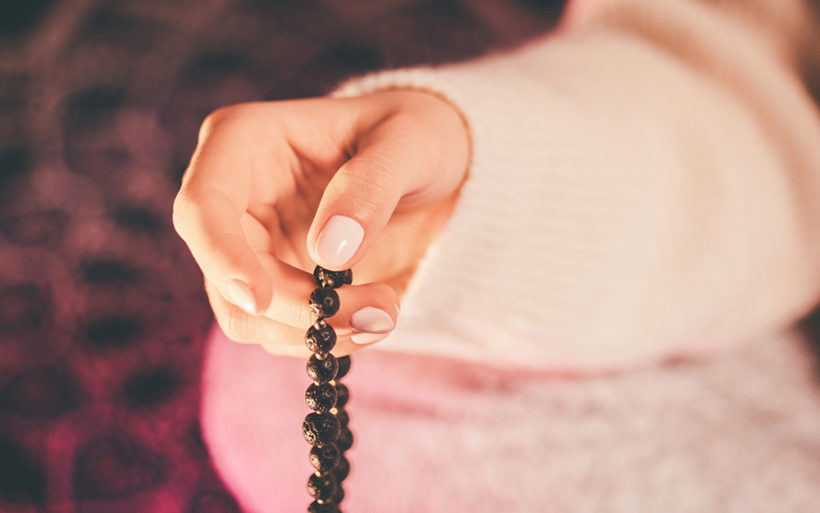
As we’ve said, the act of counting Mala beads is common to many traditions but it’s also part of an ancient practice that has its main roots in Buddhism and Hinduism. In both these religions, Mala beads were used for a specific type of meditation, the Japamala, which combines the counting of beads with the recitation of a so-called “Japa”, a particular mantra, or other sacred sounds.
Originally it was said that only the most devoted practitioner after practicing Japamala while taking 108 breaths could potentially undergo the divine experience of enlightenment. Today this meditation is still widely practiced by many and its use extends also beyond religious purposes. That is so because a consistent practice of this meditation is proven to have a wide range of physical, spiritual, and mental benefits, such as:
- It can help reduce stress
- Reduces blood pressure and heart rate
- Calms down the nervous system
- Improve sleep
- Enhances focus and memory
How to Use Mala Beads?
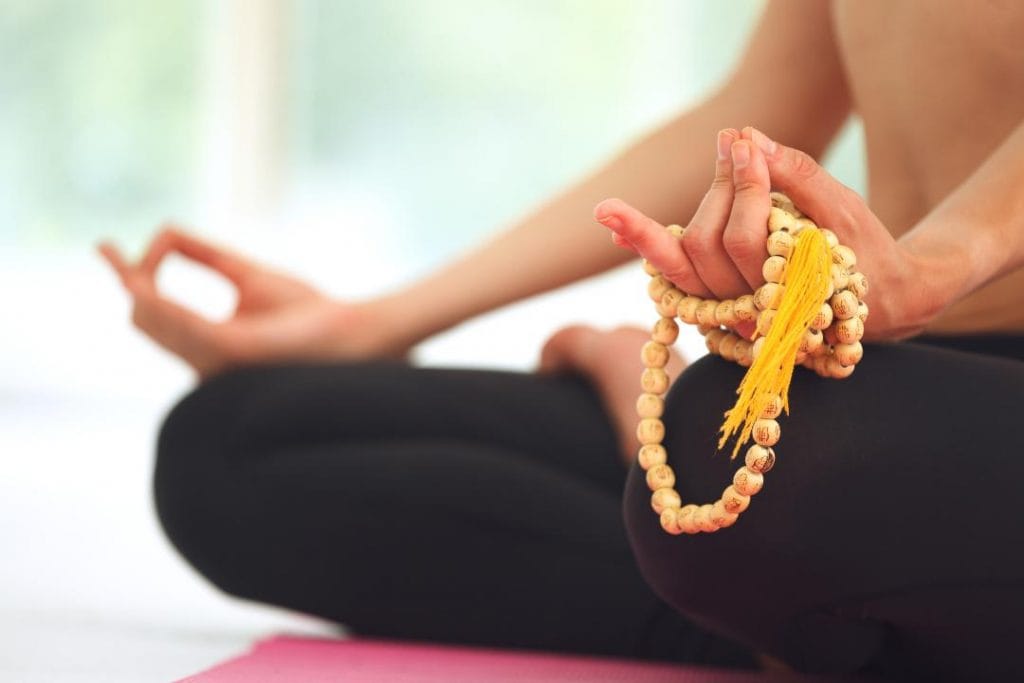
Mala beads are usually worn as necklaces to remind you of your dharma, your “righteousness” or purpose. Now, are you maybe thinking about getting your own Mala but don’t like wearing necklaces? Well, if you think that Mala can be worn only as a necklace you might have to think twice because they may actually be worn by practitioners in several ways, just to name a few:
- They may be wrapped multiple times around the wrist
- Traditionally, some practitioners wear mala around the waist, as a sort of belt
- They can be carried in small, useful pouches from which they can be removed before the practice
- If you want to keep them in a safe place, consider storing your mala in special jewelry boxes. Otherwise, if you really want to give a special value to your mala you can create your unique altar and hang it there when they’re not being used.
- You can also place the mala on a pillow or a book when practicing yoga, to remind yourself of your “Dharma” as well as your “Sankalpa”, your intention.
Before start using mala beads remember that there are two golden rules you should always keep in mind when practicing: The first is to never place the Mala on the ground because the tradition has it that positioning sacred objects in contact with the ground is actually a sign of great disrespect.
On top of that, still connected to the tradition of the Malas, you should also ensure you never touch them with the pointing finger because it is originally related to the ego.
So that being said, let’s now explore how to use them step by step:
- Sit in a comfortable seated pose, spine straight, and try to make sure that you keep the shoulders away from the ears
- Think about the mantra you intend to chant, you can also recite it mentally, but if you’re dubious about which one to choose, you might want to check online or take a look at the section below to see if you can find the one that fits your purpose
- Start from the “guru” bead and proceed step by step, bead after bead
- Hold each mala bead between your thumb and middle finger, and recite your chosen mantra
- Breath in and as you exhale, proceed to the next bead and do the same process
- Keep a steady rhythm and try to stay focused as long as you can
- When you’ve reached the last bead, exhale and empty your lungs completely. Then inhale to return to natural breathing, taking some time to feel the effects of this incredibly powerful practice.
Finding your Mala for a specific purpose
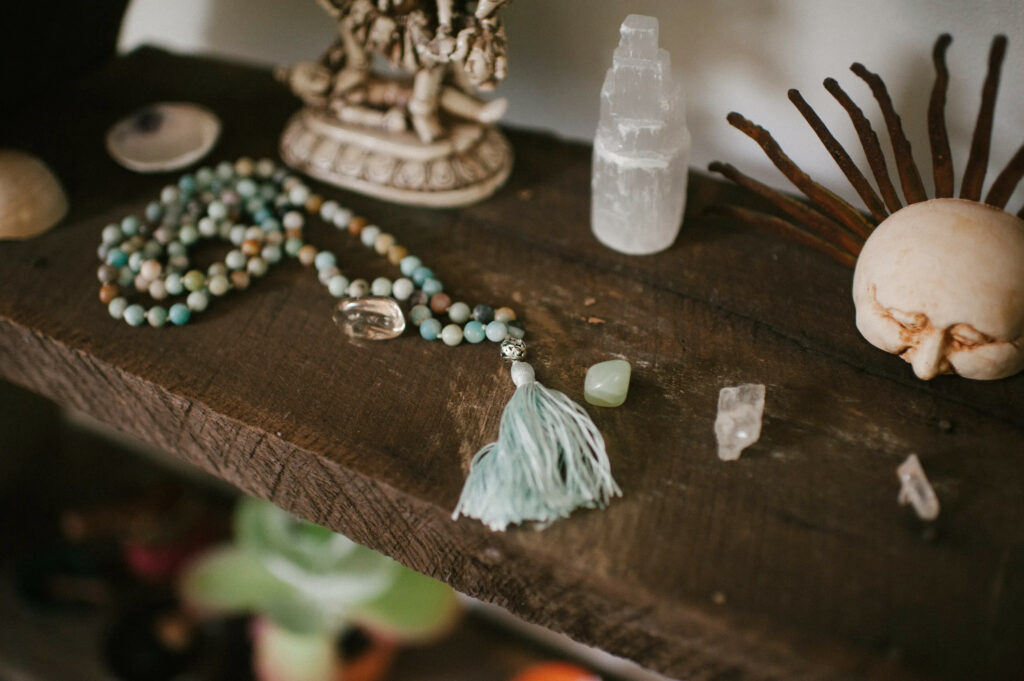
Now you might wonder: “How do I choose the right mala for me?”. Well, the thing is that as you can imagine, each mala bead carries its own significance and intention. Every mala can be made using a specific crystal, wood, or a particular mix of herbs that can trigger a certain type of energy in our body, mind, and soul.
So, it’d be ideal if you could discover more about the material from which your mala is made, to know what you can really expect from it. For this reason, when browsing for your perfect mala beads, I warmly encourage you to ask yourself: “What is my intention?” “What am I trying to manifest?” “Am I looking to cultivate more balance, more abundance, or more strength into my existence?”
If you’re still confused about what to go for, no worries, we’ve got you covered. Simply take a look at the shortlist of different materials, their effects, and the mantra that could be combined with them:
- Mala for Protection: ideal for this purpose is the turquoise, a stone that is said to have incredible healing effects on body, mind, and soul. In addition, it is also believed to act as a shield that can protect you and purify your system from any negative energy. Pair this mala with the mantra: “I have the inner ability to heal and I can protect myself from evil”
- Mala for Balance: are you going through tough times and feel like you need to achieve balance in your life? Then opt for a mala made with gemstones like Jasper, which is traditionally considered to bring balance and harmony into our system. For an enhanced effect, try to combine it with suggestive mantras such as: “I am a harmonious being” and “ I feel aligned with my purpose”.
- Mala for Strength: historically, the lava stone was believed to promote strength when facing challenging situations, so if you’re seeking strength and resilience it’d be great to get yourself a mala with this particular stone and combine it with mantras such as “I Am strong, I’m resilient, I have the power to face any challenge”.
- Mala for Clarity: those of us who are on the other hand seeking clarity and peace of mind should opt for a Mala made with clear quartz, an incredibly mighty stone that allows you to align yourself with your crown chakra, the seat of the higher self. If you go for this Mala try to recite the mantra: “I’m planet in this moment and I can see with clear eyes the world around me as well as the world inside me”
- Mala for Confidence: if all you need is to boost your confidence you should instead go for a mala that’s created with a mesmerizing stone, the blue opal. This stone is connected to the throat chakra, helping you to find your voice and to speak your truth, proudly, and with confidence. So if you’re feeling insecure and start questioning your worthiness you’d surely benefit from this kind of mala. For a stronger effect, combine it with this mantra: “I can speak my truth” as well as the mantra “I’m proud and full of confidence”.
Our top picks
Furthermore, if you’re looking for some inspiration on where to get your Mala beads, I’d strongly recommend checking out the following websites: they have all sorts of Malas in various ranges of prices in addition to a detailed description of the materials and their effects.
- https://www.malacollective.com/
- https://japamalabeads.com/shop/full-malas/
- https://buddhagroove.com/collections/meditation-mala-beads
Caring for your Mala
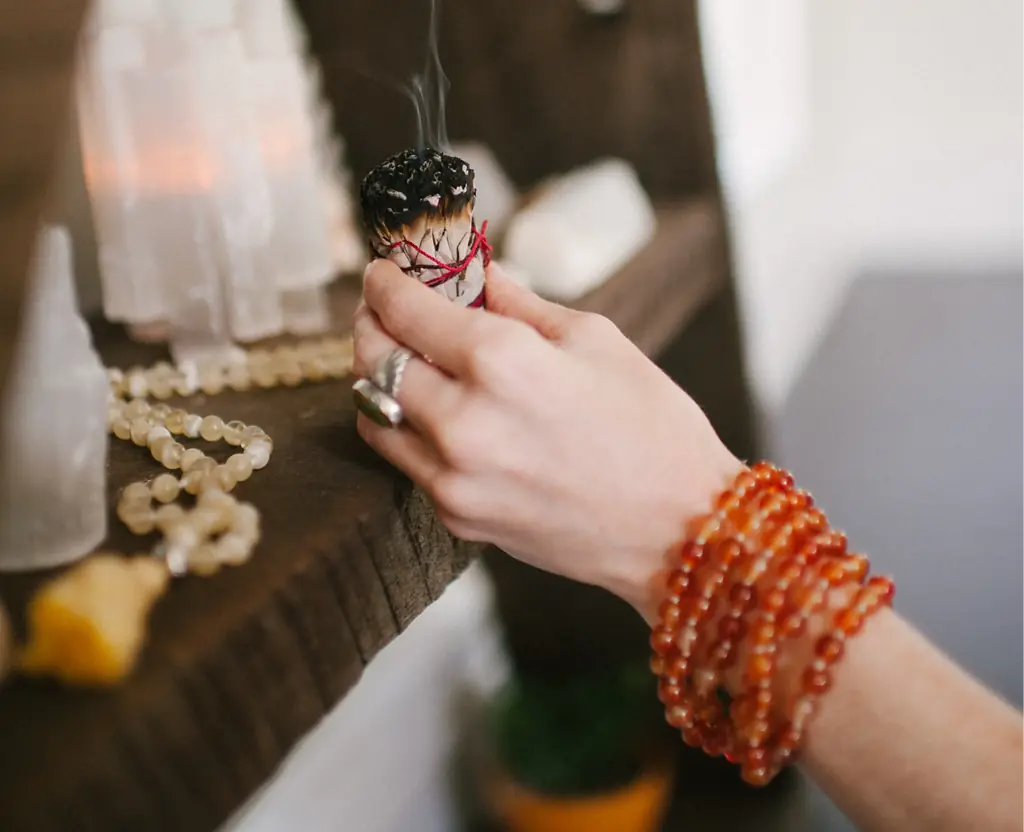
Over time, the seeds of your Mala tend to get darker as they absorb your energies as well as external elements like dirt or dust. For this reason, it’d be better to take special care of our Mala and they all have specific care according to the material of which the Mala is made.
For Malas made of wood or herbs, try to gently wash your Mala occasionally rubbing each bead with a damp cotton swab. Crystal bead Malas will instead need to be cleaned according to the crystal’s main features: some beads simply need to be washed under running lukewarm water, while others may need even extra care. Simply follow the instructions provided by your seller.
Another method that was traditionally used to clean, purify and restore the Mala beads is either with sage or with the so-called “Tingsha cymbals”, some small cymbals frequently used in rituals by Tibetan Buddhist practitioners. Both these ancient methods are said to effectively reinforce your Mala, bringing it back to its original, pristine energy.
Final thoughts
So we’ve finally come to the end of our article on Mala beads. In this article, we’ve dived deep into their fascinating history, exploring their deep significance and benefits.
As a last side note, remember that a mala doesn’t need to include fancy or pricey gemstones to be effective, simply try to choose the one that truly feels right to you.
That being said, I do hope this article has shed more light on this beautiful, ancient practice so as to help you find the perfect mala beads for your practice.


